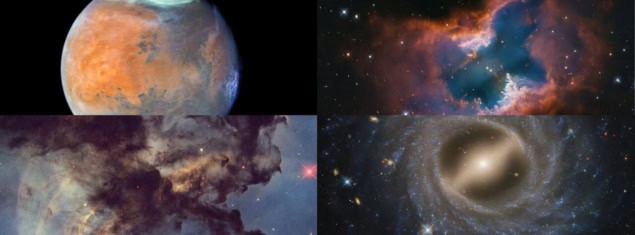Spectacular images of the cosmos released to celebrate Hubble’s 35 years in orbit
 |
A series of spectacular images of the cosmos has been released to celebrate the Hubble Space Telescope‘s 35th anniversary in space. The images include pictures of Mars, planetary nebulae, and a spiral galaxy.
Hubble was launched into low-Earth orbit in April 1990, stowed in the payload bay of the space shuttle Discovery. The telescope experienced a difficult start as its 2.4 m primary mirror suffered from spherical aberration. This fault caused the curvature of the mirror to not bring light to focus at the same point. This was fixed three years later during a daring space walk in which astronauts successfully installed the COSTAR instrument.
During its operational life, Hubble has made nearly 1.7 million observations and studied approximately 55,000 astronomical targets. Its discoveries have resulted in over 22,000 papers and over 1.3 million citations.
Operating for three decades, Hubble has allowed astronomers to observe astronomical changes such as seasonal variability on the planets in our solar system, black hole jets travelling at nearly the speed of light, stellar convulsions, asteroid collisions, and expanding supernova bubbles.
Despite being 35 years in orbit around the Earth, Hubble is still one of the most sought-after observatories, with demand for observing time oversubscribed by 6:1.
“[Hubble’s] stunning imagery inspired people across the globe, and the data behind those images revealed surprises about everything from early galaxies to planets in our own solar system,” notes Shawn Domagal-Goldman, acting director of NASA’s astrophysics division. “The fact that it is still operating today is a testament to the value of our flagship observatories.”
from physicsworld.com 2/5/2025
Δεν υπάρχουν σχόλια:
Δημοσίευση σχολίου